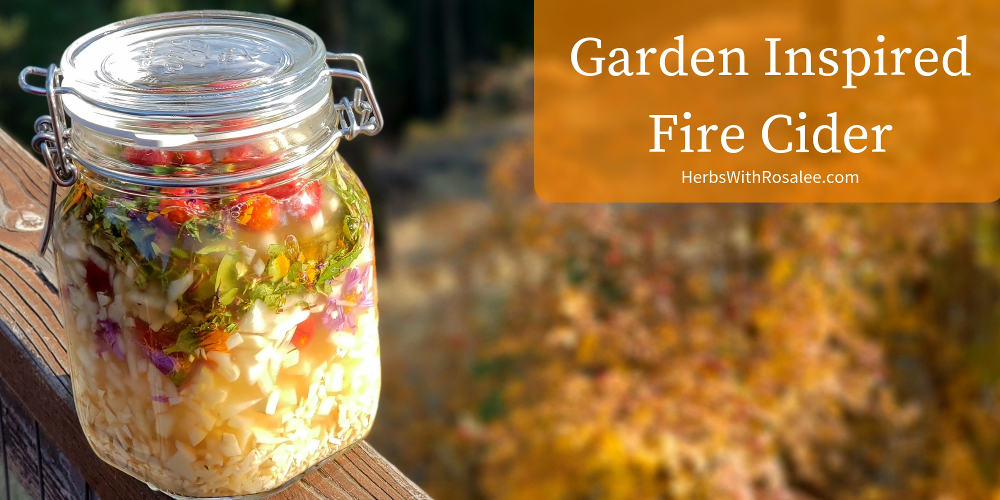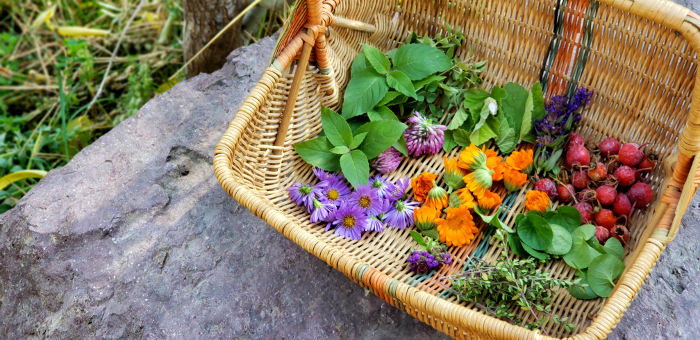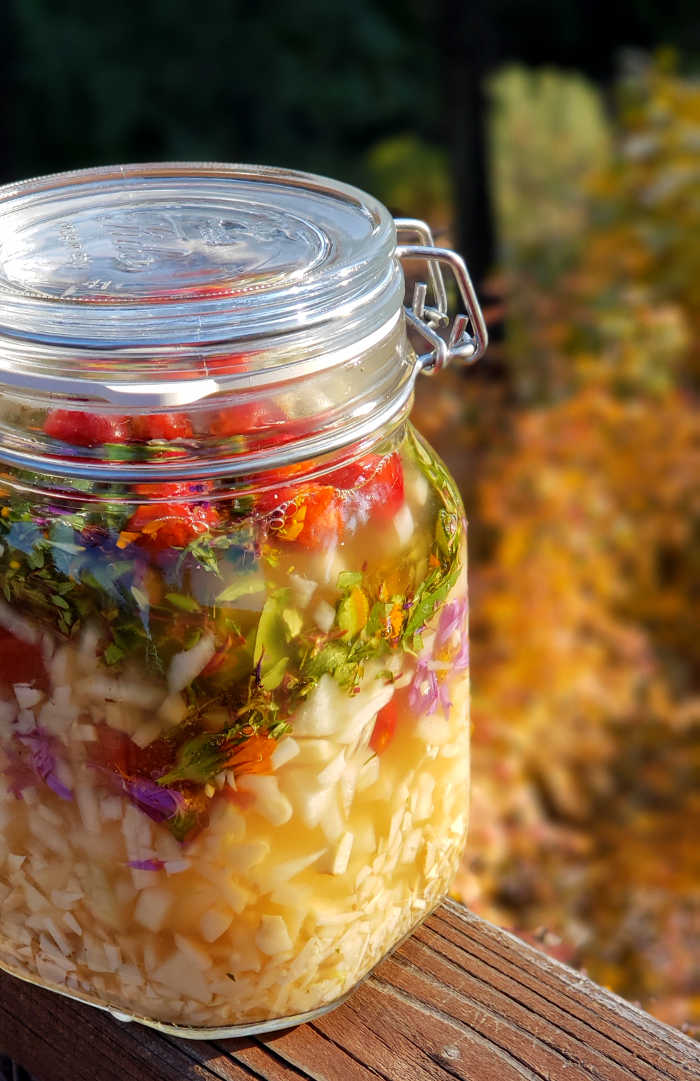Get weekly tips, recipes, and my Herbal Jumpstart e-course! Sign up for free today.

Fire Cider
Share this! |
|
Autumn is in full swing and it’s the perfect time to be making fire cider. Not only is this potent spicy brew an important addition to my home herbal apothecary, all the ingredients are fresh and available to me locally this time of year.
What is Fire Cider?
Fire cider is a vinegar-based herbal remedy that was first formulated and named by beloved herbalist Rosemary Gladstar. It is now a popular home herbal remedy and made by thousands of herbalists every year.
While the exact ingredients of the fire cider vary, the core herbs used tend to be onions, garlic, horseradish, ginger and cayenne or other hot peppers. The end result is a hot and spicy vinegar.
What's the Fire Cider Controversy?
Several years ago a company trademarked the term “Fire Cider” as it related to vinegar herbal extracts. As a result, many herbalists who were already selling their products under that name were sent cease and desist orders by the company who had trademarked the term.
Many people were upset that a traditional remedy that had been made and sold for decades was suddenly trademarked and thereby restricted to use by a single company. There is now a strong call to formally recognize fire cider as a generic term and to boycott the company that trademarked it.
For more information about this visit FreeFireCider.com.
How to Use Fire Cider
Fire cider is a powerful remedy for many symptoms of a cold or flu.
Its spicy stimulating qualities can be used to move stuck congestion in the sinuses or lungs.
It can soothe a sore throat.
Some take it as a preventive measure to avoid getting an upper respiratory infection.
I like to take it as a hot toddy when I have a cold or flu. This hot alcohol beverage warms you up, reduces aches and pains and relieves congestion.
Fire cider can be taken by the spoonful. Or it can be mixed into other mediums like smoothies, hot water or even salad dressings. I recommend starting with smaller amounts at first as this spicy blend can cause stomach upset if taken in large dosages.
Garden-Inspired Fire Cider
A few days ago I was in the garden enjoying the incredible fall weather we’ve been having. For weeks now we’ve had bright blue sunny skies with daytime temperatures in the mid 60s. At night the temperatures are around freezing and my garden is noticeably subdued compared to the summer months.
As I was walking up and down the pathways I noticed there were still some beautiful and vibrant herbs here and there and I started harvesting small handfuls. As my basket filled I realized that all the herbs I was gathering had benefits for symptoms of cold and the flu. I then got the idea to make a fire cider with all of it, an Autumn Garden Fire Cider.
While the amounts of these additional herbs are small, they offer a unique flavor profile in addition to the spicy and pungent herbs like onions, garlic and horseradish.
Here’s what I included…
- thyme
- oregano
- New England Aster flowers
- calendula flowers
- self heal flowers
- hyssop leaves and flowers
- bee balm leaves
- marshmallow leaves
- violet leaves
- red clover flowers
Autumn Garden Fire Cider
This version of fire cider accentuates the herbs available to me in October in my northern climate. I offer the following not so much as a strict recipe, but more as an inspiration to you. What’s growing around you that can be infused into your own local fire cider? If you don’t have a garden, check with your local farmers to see what’s offered. In this way, fire cider can become like a fine wine. You can recall the special blend of 2018 and how that compared to the following years.
Ingredients:
- 1 1/2 cups chopped onions
- 1/2 cup grated horseradish
- 1/2 cup minced garlic
- 1 large handful fresh whole rose hips
- 1/2 cup total of fresh garden herbs including thyme, oregano, New England Aster flowers, calendula flowers, self heal flowers, hyssop flowers and leaves, bee balm leaves, marshmallow leaves, violet leaves, red clover flowers
- 1/4 cup honey
- 2 1/2 cups apple cider vinegar
Place all the herbs into a quart glass jar (I used a 30 ounce flip top jar).
Add the honey.
Pour in the vinegar until it is 1/4 inch from the top of the jar.
Cover with a non-reactive lid, preferably glass. You can also use a plastic lid. Or, use parchment paper as a barrier between the liquid and a metal lid.
Let sit for 2-4 weeks. Give it a taste regularly to see how it develops.
When ready, strain. This is best when used within 1 year.

Rosalee is an herbalist and author of the bestselling book Alchemy of Herbs: Transform Everyday Ingredients Into Foods & Remedies That Healand co-author of the bestselling book Wild Remedies: How to Forage Healing Foods and Craft Your Own Herbal Medicine. She's a registered herbalist with the American Herbalist Guild and has taught thousands of students through her online courses. Read about how Rosalee went from having a terminal illness to being a bestselling author in her full story here.


